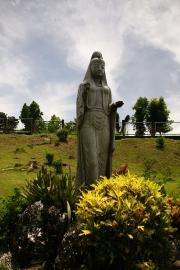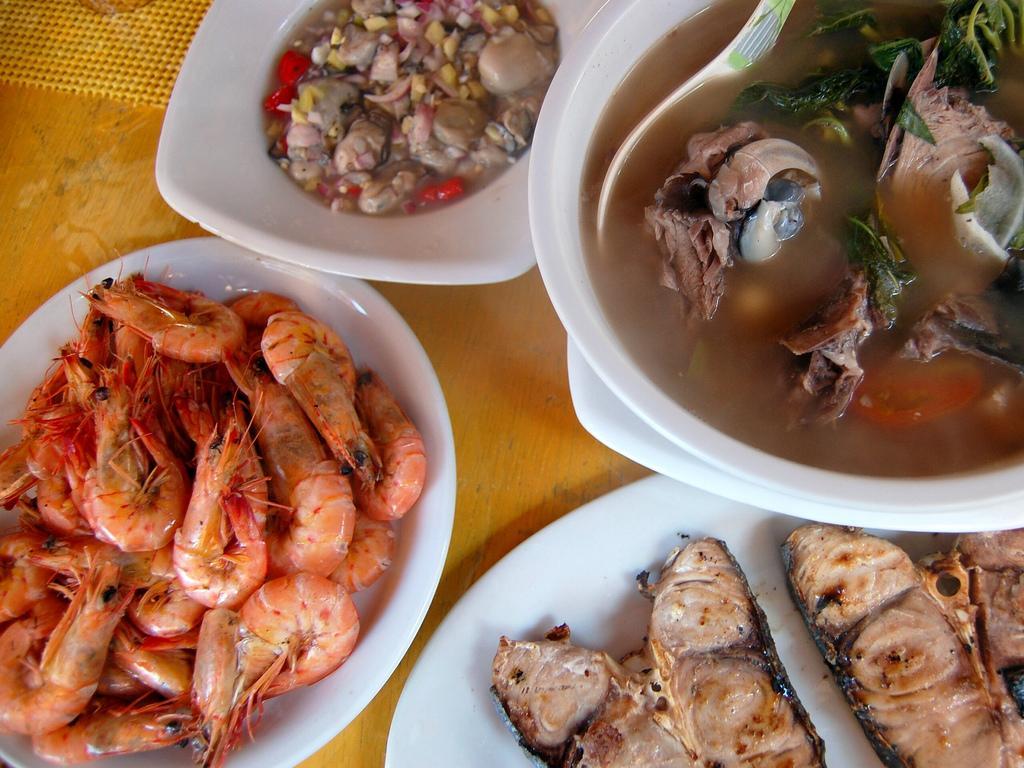
The style of cooking and the food associated with Philippine cuisine have evolved over many centuries from its Austronesian origins to a mixed cuisine with many Malay, Indian, Arab, Chinese, Spanish, Japanese, American, and other Asian and Latin influences adapted to indigenous ingredients and the local palate.
Characteristics
Filipino cuisine is distinguished by its bold combination of sweet (tamis), sour (asim), and salty (alat) flavors. While other Asian cuisines may be known for a more subtle delivery and presentation, Filipino cuisine is often delivered all at once in a single presentation.
Counterpoint is a feature in Philippine cuisine which normally comes in a pairing of something sweet with something salty, and results in surprisingly pleasing combinations. Examples include:
- champorado (a sweet cocoa rice porridge), being paired with tuyo (salted, sun-dried fish)
- dinuguan (a savory stew made of pig's blood and innards), paired with puto (sweet, steamed rice cakes)
- unripe fruits such as mangoes (which are only slightly sweet but very sour), are eaten dipped in salt or bagoong
- the use of cheese (which is salty) in sweetcakes (such as bibingka and puto), as well as an ice cream flavoring
Vinegar is a common ingredient. Adobo is popular not solely for its simplicity and ease of preparation, but also for its ability to be stored for days without spoiling, and even improve in flavor with a day or two of storage. Tinapa is a smoke-cured fish while tuyo, daing, and dangit are corned, sun-dried fish popular because they can last for weeks without spoiling, even without refrigeration.
Common Dishes
As with most Asian countries, the staple food in the Philippines is rice. It is most often steamed and served during meals. Leftover rice is often fried with garlic to make sinangag, which is usually served at breakfast together with a fried egg and cured meat or sausages. Rice is often enjoyed with the sauce or broth from the main dishes. In some regions, rice is mixed with salt, condensed milk, cocoa, or coffee. Rice flour is used in making sweets, cakes and other pastries. While rice is the main staple food, bread is also a common staple.

A variety of fruits and vegetables are often used in cooking. Bananas (the saba variety in particular), kalamansi, guavas (bayabas), mangoes, papayas, and pineapples lend a distinctly tropical flair in many dishes, but mainstay green leafy vegetables like water spinach (kangkong), Chinese cabbage (petsay), Napa cabbage (petsay wombok), cabbage (repolyo) and other vegetables like eggplants (talong) and yard-long beans (sitaw) are just as commonly used. Coconuts are ubiquitous. Coconut meat is often used in desserts, coconut milk (kakang gata) in sauces, and coconut oil for frying. Abundant harvests of root crops like potatoes, carrots; taro (gabi), cassava (kamoteng kahoy), purple yam (ube), and sweet potato (kamote) make them readily available. The combination of tomatoes (kamatis), garlic (bawang), and onions (sibuyas) is found in many dishes.
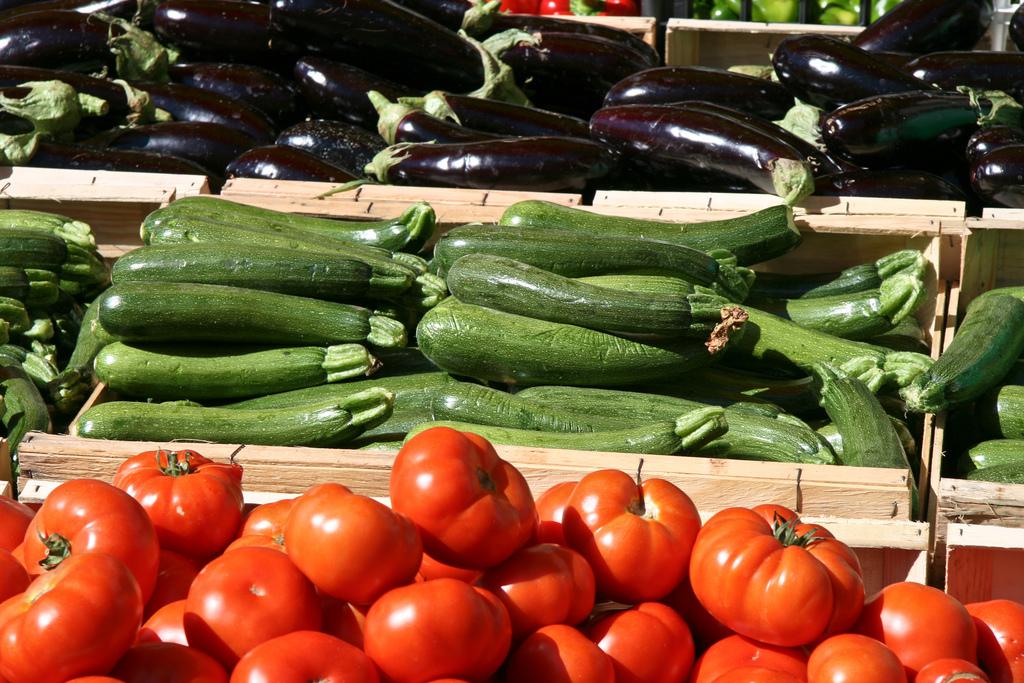
Meat staples include chicken, pork, beef, and fish. Seafood is popular as a result of the bodies of water surrounding the archipelago. Popular catches include tilapia, catfish (hito), milkfish (bangus), grouper (lapu-lapu), shrimp (hipon), prawns (sugpo), mackerel (galunggong, hasa-hasa), swordfish, oysters (talaba), mussels (tahong), clams (halaan and tulya), large and small crabs (alimango and alimasag respectively), game fish, sablefish, tuna, cod, blue marlin, and squid/cuttlefish (both called pusit). Also popular are seaweeds, abalone, and eel.
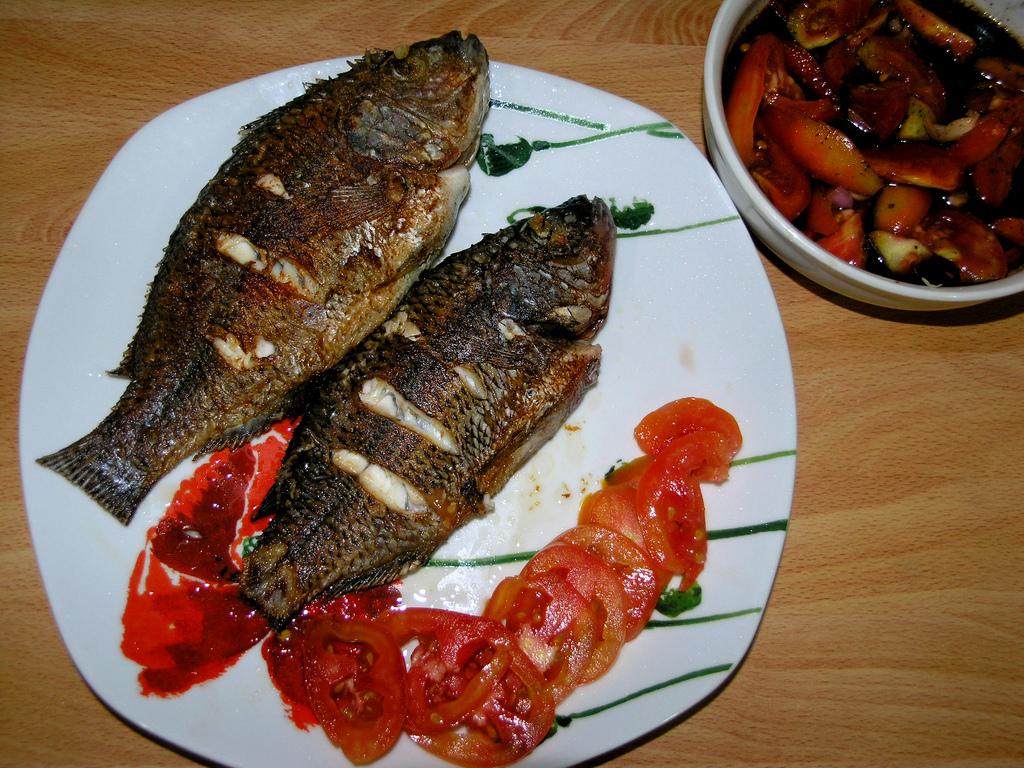
The most common way of having fish is to have it salted, pan-fried or deep-fried, and then eaten as a simple meal with rice and vegetables. It may also be cooked in a sour broth of tomatoes or tamarind as in pangat, prepared with vegetables and a souring agent to make sinigang, simmered in vinegar and peppers to make paksiw, or roasted over hot charcoal or wood (inihaw). Other preparations include escabeche (sweet and sour), relleno (deboned and stuffed), or "kinilaw" (similar to ceviche; marinated in vinegar or kalamansi). Fish can be preserved by being smoked (tinapa) or sun-dried (tuyo or daing).
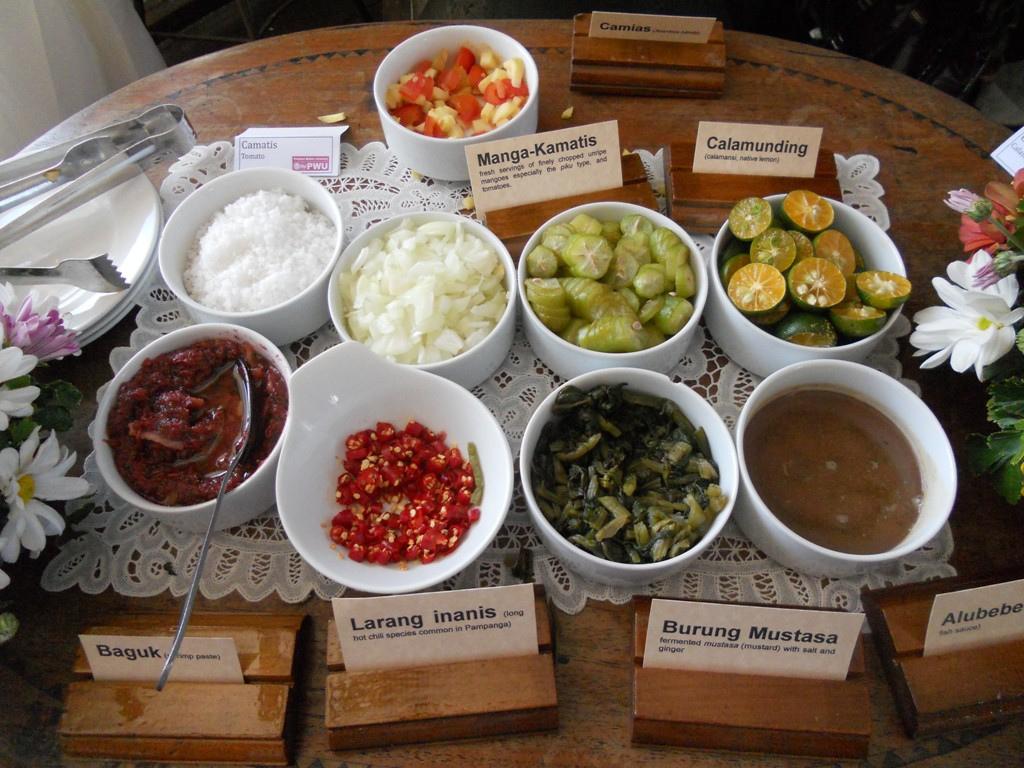
Food is often served with various dipping sauces. Fried food is often dipped in vinegar, soy sauce, juice squeezed from kalamansi (Philippine lime or calamansi), or a combination of two or all. Patis (fish sauce) may be mixed with kalamansi as dipping sauce for most seafood. Fish sauce, fish paste (bagoong), shrimp paste (bagoong alamang) and crushed ginger root (luya) are condiments that are often added to dishes during the cooking process or when served.
Breakfast
A traditional Filipino breakfast might include pandesal (small bread rolls), kesong puti (white cheese), champorado (chocolate rice porridge), sinangag (garlic fried rice), and meat—such as tapa, longganisa, tocino, karne norte (corned beef), or fish such as daing na bangus (salted and dried milkfish)—or itlog na pula (salted duck eggs). Coffee is also commonly served particularly kapeng barako, a variety of coffee produced in the mountains of Batangas noted for having a strong flavor.
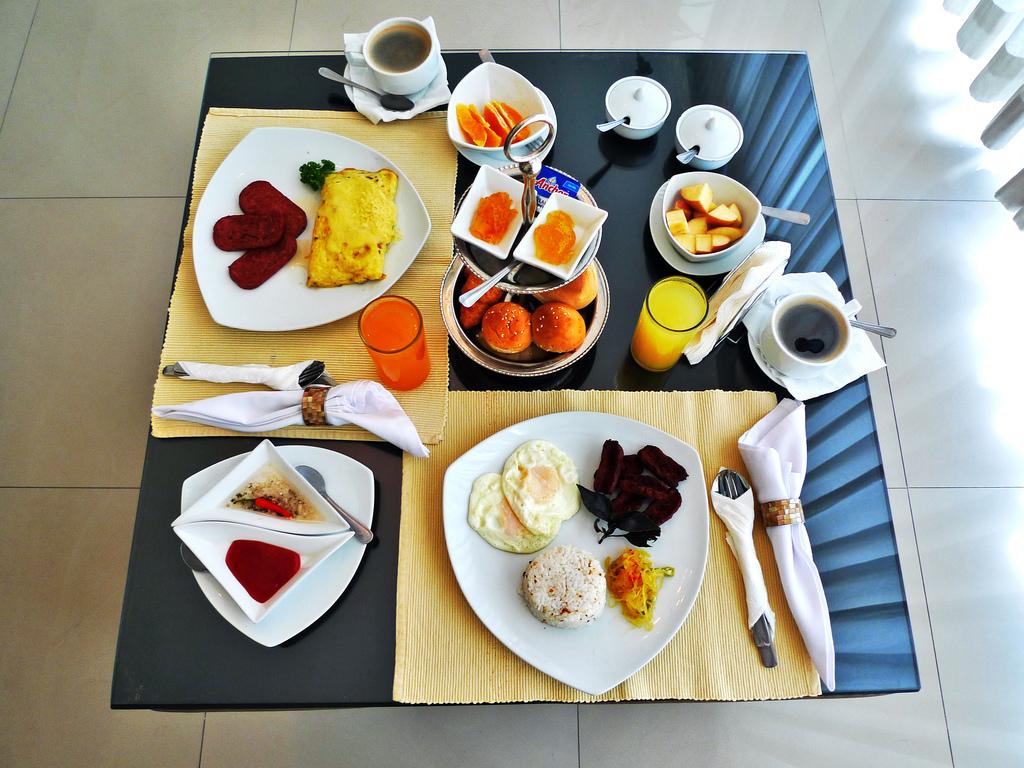
Certain portmanteaus in Filipino have come into use to describe popular combinations of items in a Filipino breakfast. An example of such a combination order is kankamtuy: an order of kanin (rice), kamatis (tomatoes) and tuyo (dried fish). Another is tapsi: an order of tapa and sinangág. Other examples include variations using a silog suffix, usually some kind of meat served with sinangág and itlog (egg). The three most commonly seen silogs are tapsilog (having tapa as the meat portion), tocilog (having tocino as the meat portion), and longsilog (having longganisa as the meat portion). Other silogs include hotsilog (with a hot dog), bangsilog (with bangus (milkfish)), dangsilog (with danggit (rabbitfish)), spamsilog (with spam), adosilog (with adobo), chosilog (with chorizo), chiksilog (with chicken), cornsilog (with corned beef), and litsilog (with lechon/litson). Pankaplog is a slang term referring to a breakfast consisting of pandesal, kape (coffee), and itlog (egg). An establishment that specializes in such meals is called a tapsihan or "tapsilugan".
Merienda
Merienda is taken from the Spanish, and is a light meal or snack especially in the afternoon, similar to the concept of afternoon tea. If the meal is taken close to dinner, it is called merienda cena, and may be served instead of dinner.
Filipinos have a number of options to take with their traditional kape (coffee): breads and pastries like pandesal, ensaymada (buttery sweet rolls covered with cheese), hopia (pastries similar to mooncakes filled with sweet bean paste) and empanada (savory pastries stuffed with meat). There's also the option of cakes made with sticky rice (kakanin) like kutsinta, sapin-sapin, palitaw, biko, suman, bibingka, and pitsi-pitsi.
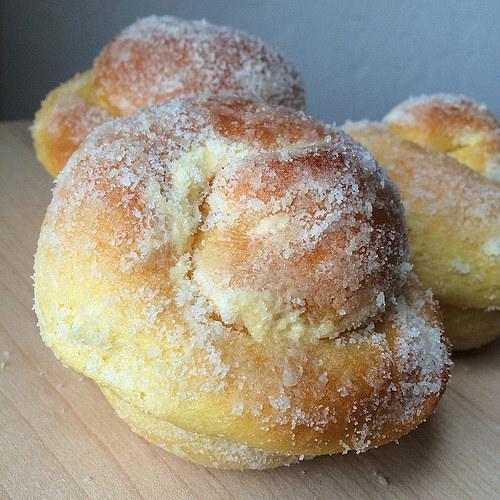
Savory dishes often eaten during merienda include pancit canton (stir-fried noodles), palabok (rice noodles with a shrimp-based sauce), tokwa't baboy (fried tofu with boiled pork ears in a garlic-flavored soy sauce and vinegar sauce), and dinuguan (a spicy stew made with pork blood) which is often served with puto (steamed rice flour cakes).
Dim sum and dumplings, brought over by the Fujianese people, have been given a Filipino touch and are often eaten for merienda. Street food, most of which are skewered on bamboo sticks, such as squid balls, fish balls and others, are common choices too.
Pulutan
Pulutan (from the Filipino word pulutin which literally means "something that is picked up") is a term roughly analogous to the English term "finger food". Originally, it was a snack accompanied with liquor or beer but has found its way into Philippine cuisine as appetizers or, in some cases, main dishes, as in the case of sisig.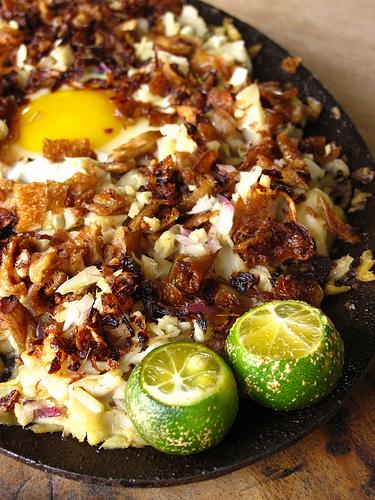
Deep fried pulutan include chicharrón (also spelled chicharon or tsitsaron), pork rinds that have been salted, dried, then fried; chicharong bituka, pig intestines that have been deep fried to a crisp; chicharong bulaklak, similar to chicharong bituka it is made from mesenteries of pig intestines and has a bulaklak or flower appearance; and chicharong manok, chicken skin that has been deep fried until crisp.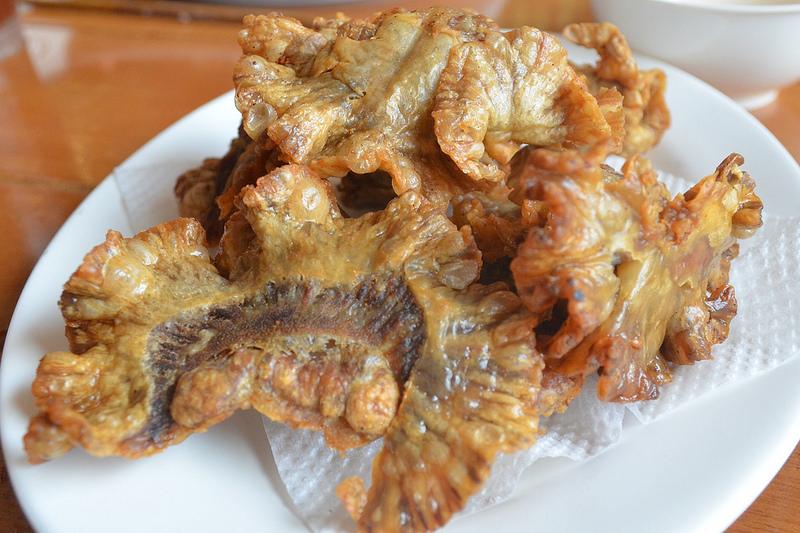
Some grilled food include barbecue isaw, chicken or pig intestines marinated and skewered; barbecue tenga, pig ears that have been marinated and skewered; pork barbecue which is skewered pork marinated in a usually sweet blend; betamax, salted solidified pork or chicken blood which is skewered; adidas which is grilled or sautéed chicken feet. And there is sisig a popular pulutan made from the pig's cheek skin, ears and liver that is initially boiled, then grilled over charcoal and afterwards minced and cooked with chopped onions, chillies, and spices.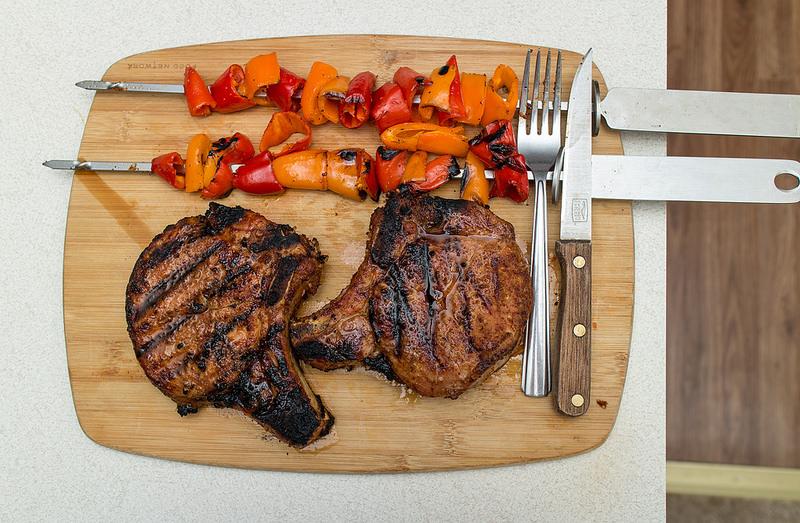
Smaller snacks such as mani (peanuts) are often sold boiled in the shell, salted, spiced or flavored with garlic by street vendors in the Philippines. Another snack is kropeck, which is fish crackers.
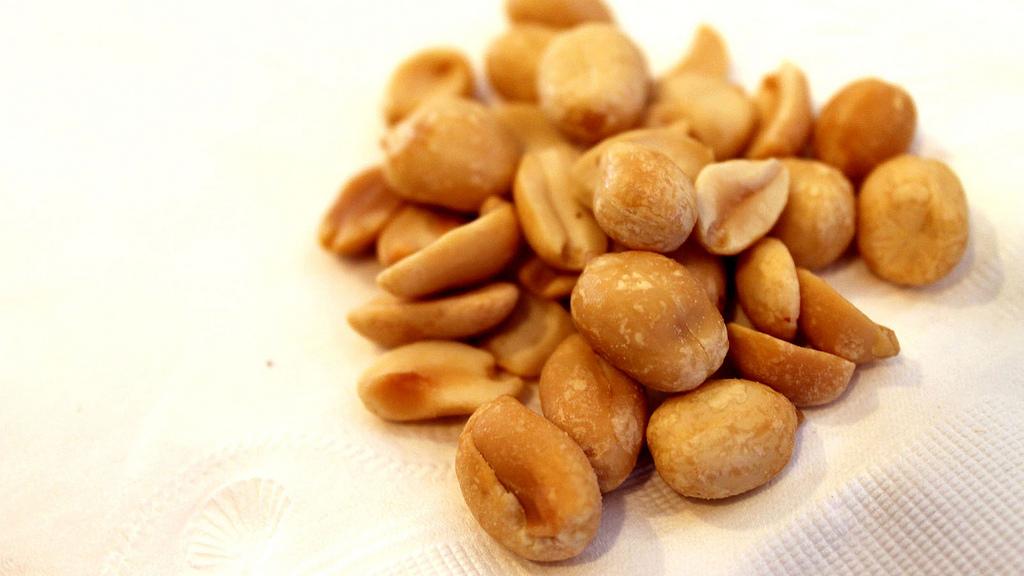
Fried tokwa't baboy is tofu fried with boiled pork then dipped in a garlic-flavored soy sauce or vinegar dip that is also served as a side dish to pancit luglog or pancit palabok.
Breads and Pastries
In a typical Filipino bakery, pandesal, monay and ensaymada are often sold. Pandesal comes from the Spanish pan de sal (literally, bread of salt), and is a ubiquitous breakfast fare, normally eaten with (and sometimes even dipped in) coffee. It typically takes the form of a bread roll, and is usually baked covered in bread crumbs. Contrary to what its name implies, pandesal is not particularly salty as very little salt is used in baking it. Monay is a firmer slightly denser heavier bread. Ensaymada, from the Spanish ensaimada, is a pastry made using butter and often topped with sugar and shredded cheese that is especially popular during Christmas. It is sometimes made with fillings such as ube (purple yam) and macapuno (a variety of coconut the meat of which is often cut into strings, sweetened, preserved, and served in desserts). Also commonly sold in Filipino bakeries is pan de coco, a sweet roll filled with shredded coconut mixed with molasses. Putok, which literally means "explode", refers to a small, hard bread roll whose cratered surface is glazed with sugar. Kababayan is a small, sweet gong-shaped muffin that has a moist consistency. Spanish bread refers to a rolled pastry which looks like a croissant prior to being given a crescent shape, and has a filling consisting of sugar and butter.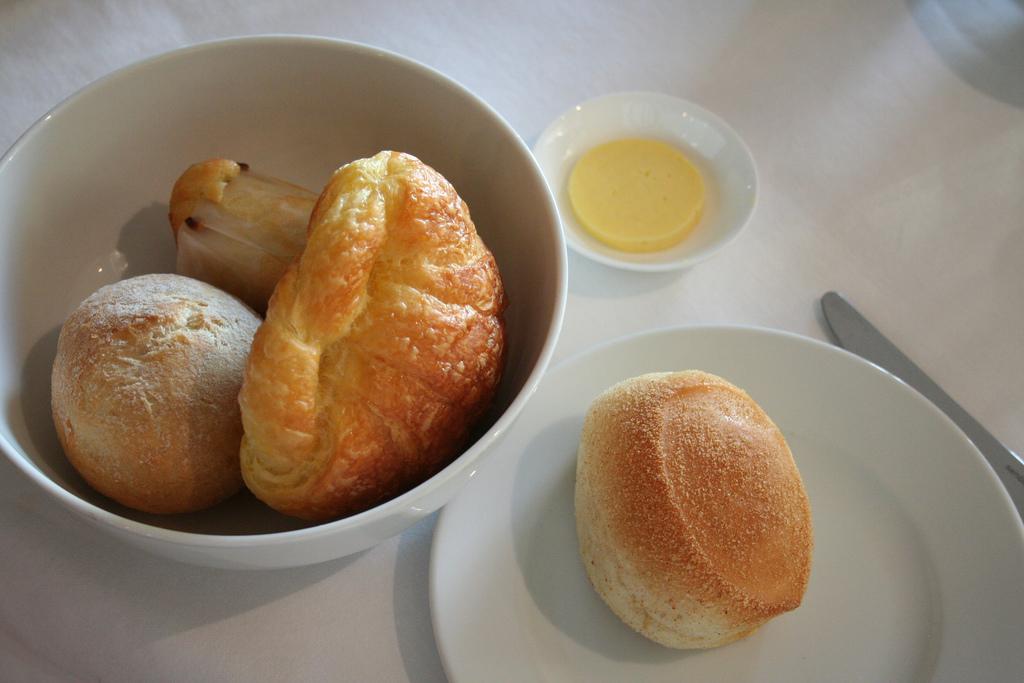
There are also rolls like pianono, which is a chiffon roll flavored with different fillings. Brazo de mercedes, a rolled cake or jelly roll, is made from a sheet of meringue rolled around a custard filling. Similar to the previous dessert, it takes on a layered presentation instead of being rolled and typically features caramelized sugar and nuts for sans rival. Silvañas are large, oval-shaped, cookie-sized desserts, with a thin meringue on either side of a buttercream filling and dusted with crumbed cookies. Not overly sweet, they are rich, crisp, chewy, and buttery all at the same time. Barquillos use sweet thin crunchy wafers rolled into tubes that can be sold hollow or filled with polvoron (sweetened and toasted flour mixed with ground nuts). Meringues are also present in the Philippines, due to the Spanish influence, but they are called merengue – with all the vowels pronounced. Leche flan is a type of caramel custard made with eggs and milk similar to the French creme caramel. Leche flan (the local term for the originally Spanish flan de leche, literally "milk flan"), which is a heavier version of the Spanish flan made with condensed milk and more egg yolks. Leche flan is usually steamed over an open flame or stove top, although rarely it can also be seen baked. Leche flan is a staple in celebratory feasts.
The egg pie with a very rich egg custard filling is a mainstay in local bakeries. It is typically baked so that the exposed custard on top is browned. Buko pie is made with a filling made from young coconut meat and dairy. Mini pastries like turrones de casuy are made up of cashew marzipan wrapped with a wafer made to resemble a candy wrapper but take on a miniature look of a pie in a size of about a quarter. There is also napoleones – again with all the vowels pronounced – a mille-feuille pastry stuffed with a sweet milk-based filling.
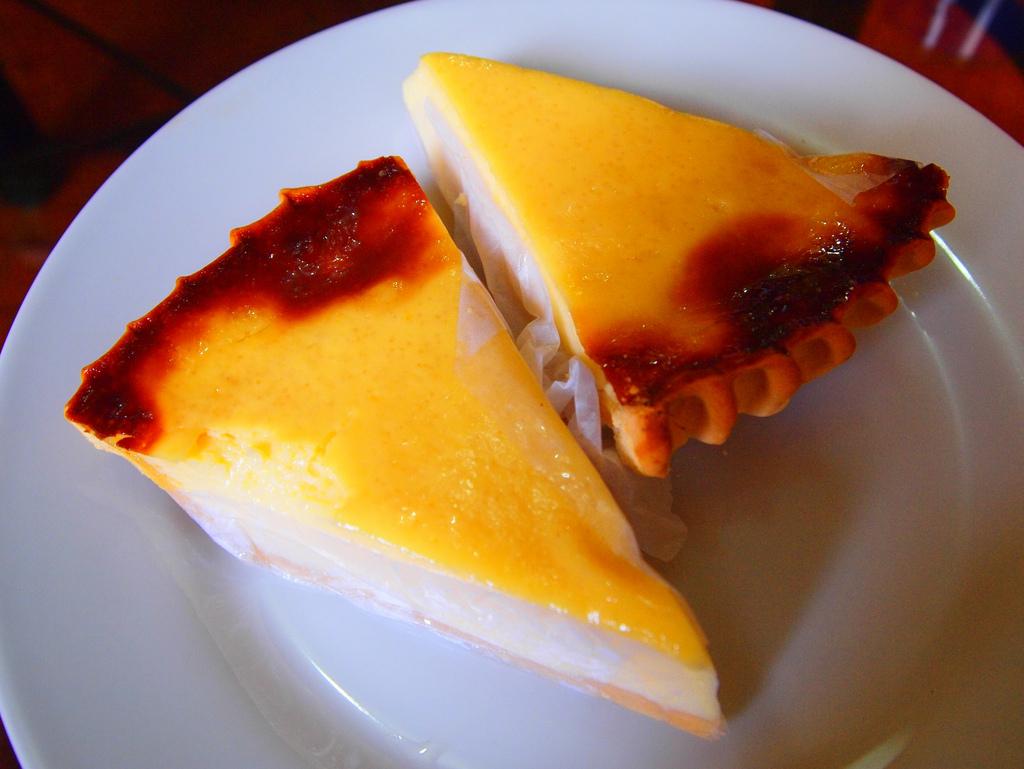
There are hard pastries like biskotso, a crunchy, sweet, twice-baked bread. Another baked goody is sinipit which is a sweet pastry covered in a crunchy sugar glaze, made to resemble a length of rope. Similar to sinipit is a snack eaten on roadsides colloquially called shingaling. It is hollow but crunchy with a salty flavor.
For a softer treat there is mamon a chiffon-type cake sprinkled with sugar, its name derived from a slang Spanish term for breast. There's also crema de fruta, which is an elaborate sponge cake topped in succeeding layers of cream, custard, candied fruit, and gelatin. Similar to a sponge cake is mamoncillo which generally refers to slices taken from a large mamon cake, but it is unrelated to the fruit of the same name. Sandwich pastries like inipit are made with two thin layers of chiffon sandwiching a filling of custard that is topped with butter and sugar. Another mamon variant is mamon tostada, basically mamoncillo toasted to a crunchy texture.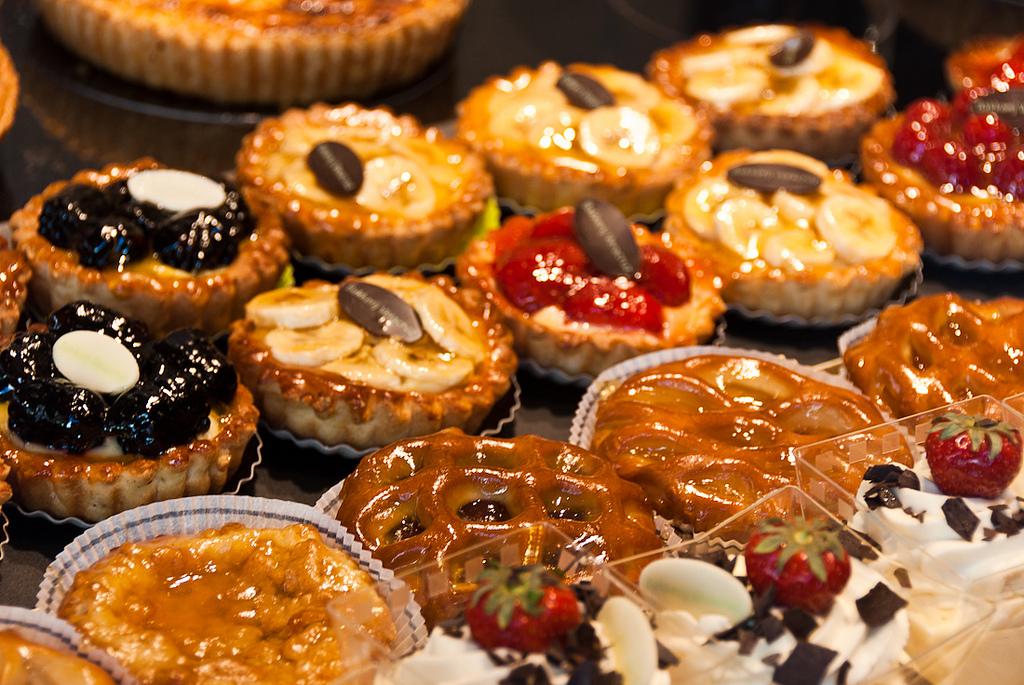
Stuffed pastries of both Western and Eastern influence are common. One can find empanadas, turnover-type pastry filled with a savory-sweet meat filling. Typically made with ground meat and raisins, it can be deep fried or baked. Siopao is the local version of Chinese baozi. Buchi is another snack probably of Chinese origin. Bite-sized, buchi is made of deep-fried dough balls (often from rice flour) filled with a sweet mung bean paste, and coated on the outside with sesame seeds, some variants have ube as the filling. There are also many varieties of the mooncake-like hopia, which come in different shapes (from a flat, circular stuffed form, to cubes), and have different textures (predominantly using flaky pastry, but sometimes like the ones in mooncakes) and fillings.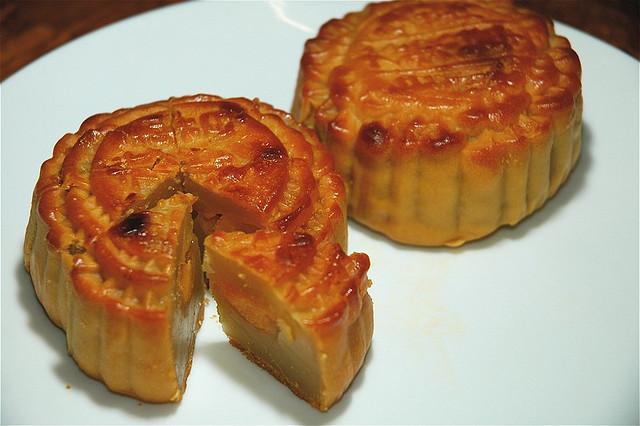
Fiesta Food
For festive occasions, people band together and prepare more sophisticated dishes. Tables are often laden with expensive and labor-intensive treats requiring hours of preparation. In Filipino celebrations, lechón (also spelled litson) serves as the centerpiece of the dinner table. It is usually a whole roasted pig, but suckling pigs (lechonillo, or lechon de leche) or cattle calves (lechong baka) can also be prepared in place to the popular adult pig. It is typically served with lechon sauce. Other dishes include hamonado (honey-cured beef, pork or chicken), relleno (stuffed chicken or milkfish), mechado, afritada, caldereta, puchero, paella, menudo, morcon, embutido (referring to a meatloaf dish, not a sausage as understood elsewhere), suman (a savory rice and coconut milk concoction steamed in leaves such as banana), and pancit canton. The table may also be have various sweets and pastries such as leche flan, ube, sapin-sapin, sorbetes (ice creams), totong (a rice, coconut milk and mongo bean pudding), ginataan (a coconut milk pudding with various root vegetables and tapioca pearls), and gulaman (an agar jello-like ingredient or dessert).

Christmas Eve, known as Noche Buena, is the most important feast. During this evening, the star of the table is the Christmas ham and Edam cheese (queso de bola). Supermarkets are laden with these treats during the Christmas season and are popular giveaways by Filipino companies in addition to red wine, brandy, groceries, or pastries. Available mostly during the Christmas season and sold in front of churches along with bibingka, puto bumbong is a purple yam-flavored puto.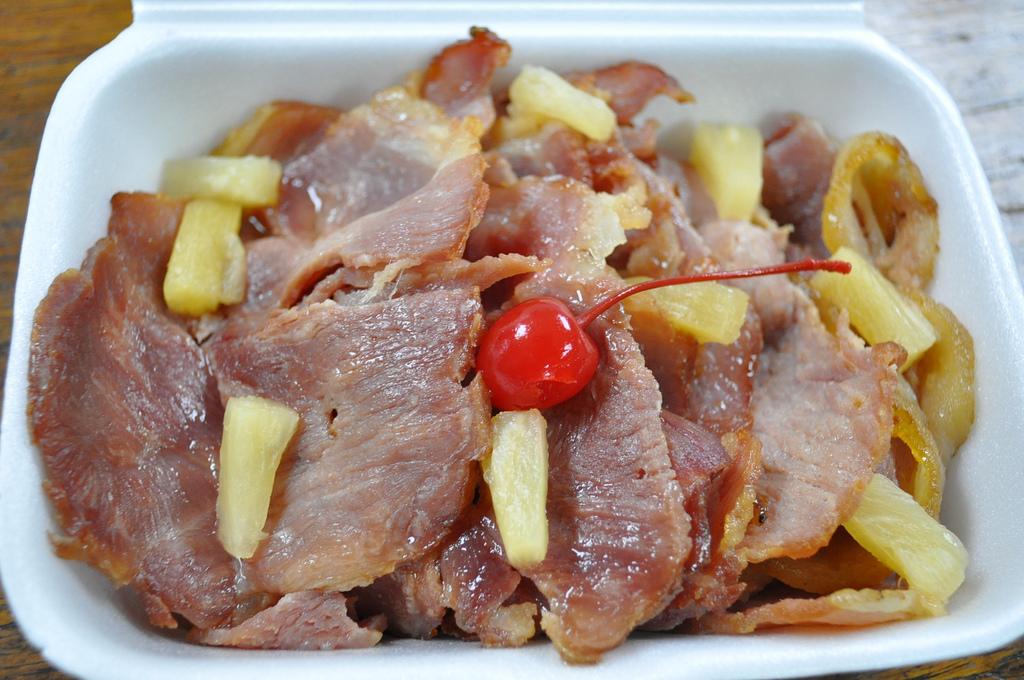
More common at celebrations than in everyday home meals, lumpiang sariwa, sometimes referred to as fresh lumpia, is a fresh spring roll that consists of a soft crepe wrapped around a filling that can include strips of kamote (sweet potato), singkamas (jicama), bean sprouts, green beans, cabbage, carrots and meat (often pork). It can be served warm or cold and typically with a sweet peanut and garlic sauce. Ukoy is shredded papaya combined with small shrimp (and occasionally bean sprouts) and fried to make shrimp patties. It is often eaten with vinegar seasoned with garlic, salt and pepper. Both lumpiang sariwa and ukoy are often accompanied together in Filipino parties. Lumpiang sariwa has Chinese origins, having been derived from popiah.
Side dishes and complements
Itlog na pula (red eggs) are duck eggs that have been cured in brine or a mixture of clay-and-salt for a few weeks, making them salty. They are later hard boiled and dyed with red food coloring, hence its name, to distinguish them from chicken eggs before they are sold over the shelves. They are often served mixed in with diced tomatoes. Atchara is a side dish of pickled papaya strips similar to sauerkraut. It's a frequent accompaniment to fried dishes like tapa or daing.
Nata de coco is a chewy, translucent, jelly-like food product produced by the fermentation of coconut water can be served with pandesal. Kesong puti is a soft white cheese made from carabao milk (although cow milk is also used in most commercial variants). Grated mature coconut (niyog) is normally served with sweet rice-based desserts.
Desserts
As a tropical oriental country, it should come as no surprise there are many treats made from rice and coconuts. One often seen dessert is bibingka, a hot rice cake optionally topped with a pat of butter, slices of kesong puti (white cheese), itlog na maalat (salted duck eggs), and sometimes grated coconut. There are also glutinous rice sweets called biko made with sugar, butter, and coconut milk. Another brown rice cake is kutsinta. Puto is another well known example of sweet steamed rice cakes prepared in many different sizes and colors. Sapin-sapin are three-layered, tri-colored sweets made with rice flour, purple yam, and coconut milk with its gelatinous appearance. Palitaw are rice patties covered with sesame seeds, sugar, and coconut; pitsi-pitsi which are cassava patties coated with cheese or coconut; and tibok-tibok is based on carabao milk as a de leche (similar to maja blanca). As a snack, binatog is created with corn kernels with shredded coconut. Packaged snacks wrapped in banana or palm leaves then steamed, suman are made from sticky rice.
For cold desserts there is halo-halo which can be described as a dessert made with shaved ice, milk, and sugar with additional ingredients like coconut, halaya (mashed purple yam), caramel custard, plantains, jackfruit, red beans, tapioca and pinipig being typical. Other similar treats made with shaved ice include saba con yelo which is shaved ice served with milk and minatamis na saging (ripe plantains chopped and caramelized with brown sugar); mais con yelo which is shaved ice served with steamed corn kernels, sugar, and milk; and buko pandan sweetened grated strips of coconut with gulaman, milk, and the juice or extract from pandan leaves. Sorbetes (ice cream) is popular too. A local version uses coconut milk instead of cow milk. Ice candy made from juice or chocolate put it in a freezer to freeze is another treat. It can be any kind of flavor depending on the maker; chocolate and buko (coconut) flavored ice candy are two of the most popular.
Street Foods and other Snacks
Aside from pastries and desserts, there are heartier snacks for merienda that can also serve as an appetizer or side dish for a meal. Siomai is the local version of Chinese shaomai. Lumpia are spring rolls that can be either fresh or fried. Fresh lumpia (lumpiang sariwa) is usually made for fiestas or special occasions as it can be labor-intensive to prepare, while one version of fried lumpia (lumpiang prito), lumpiang shanghai is usually filled with ground pork and a combination of vegetables, and served with a sweet and sour dipping sauce. Other variations are filled with minced pork and shrimp and accompanied by a vinegar-based dipping sauce. Lumpia has been commercialized in frozen food form.
There's a distinct range of street foods available in the Philippines. Some of these are skewered on sticks in the manner of a kebab. One such example is banana-cue which is a whole banana or plantain skewered on a short thin bamboo stick, rolled in brown sugar, and fried. Kamote-cue is a peeled sweet potato skewered on a stick, covered in brown sugar and then fried. Fish balls or squid balls are skewered on bamboo sticks then dipped in a sweet or savory sauce to be commonly sold frozen in markets and peddled by street vendors.
Turon, a kind of fried lumpia consisting of an eggroll or phyllo wrapper filled with plantain and jackfruit and sprinkled with sugar can also be found sold in streets.
Taho is a warm treat made up of soft beancurd, which is the taho itself, dark caramel syrup called arnibal, and tapioca pearls. It is often sold in neighborhoods by street vendors who yell out "taho" in a manner like vendors in the stands at sporting events yell out "hotdogs" or "peanuts". Sometimes taho is served chilled or flavors have been added such as chocolate or strawberry. Taho is derived from the original Chinese snack food known as douhua.
There is also iskrambol (from the English "to scramble"), that is a kind of iced-based treat like a sorbet combined with various flavorings and usually topped with chocolate syrup. It is eaten by "scrambling" the contents or mixing them, then drinking with a large straw. It was later modified into ice scramble, or simply scramble, but with added skim milk, chocolate and/or strawberry syrup, and a choice of toppings such as marshmallows, chocolate or candy sprinkles, rice crispies, or tapioca pearls.
Street food featuring eggs include kwek-kwek which are hard-boiled quail eggs dipped in orange-dyed batter and then deep fried similar to tempura. Tokneneng is a larger version of kwek-kwek using chicken or duck eggs. Another Filipino egg snack is balut, essentially a boiled pre-hatched poultry egg, usually duck or chicken. These fertilized eggs are allowed to develop until the embryo reaches a pre-determined size and are then boiled. There is also another egg dish called penoy which is basically hard-boiled unfertilized duck eggs. Like taho, balut is advertised by street hawkers calling out their product.
Okoy, also spelled as ukoy, is another batter-covered, deep-fried street food in the Philippines. Along with the batter, it normally includes bean sprouts, shredded pumpkin and very small shrimps, shells and all. It is commonly dipped in a combination of vinegar and chilli.
Among other street food are already mentioned pulutan like isaw, seasoned hog or chicken intestines; betamax, roasted dried chicken blood served cut into and served as small cubes for which it received its name in resemblance to a Betamax tape; Adidas, chicken feet named after the popular shoe brand; and proven, the proventriculus of a chicken coated in cornstarch and deep-fried. There is also pinoy fries which are fries made from sweet potatoes.
Exotic Dishes
Some exotic dishes in the Filipino diet are camaro, which are field crickets cooked in soy sauce, salt, and vinegar as it is popular in Pampanga; papaitan which is goat or beef innards stew flavored with bile that gives it a bitter (pait) taste; Soup No. 5 (Also spelled as "Soup #5") which is a soup made out of bull's testes, and can be found in restaurants in Ongpin St., Binondo, Manila; asocena or dog meat popular in the Cordillera Administrative Region.
Drinks and cocktails
- Chilled drinks and shakes
Due to the tropical climate, chilled drinks are popular. Stands selling cold fruit drinks and fruit shakes are common. Tropical fruit drinks one encounters include those based on dalandan (green mandarin), suha (pomelo), pinya (pineapple), banana, and guyabano. The shakes usually contain crushed ice, evaporated or condensed milk, and fruits like the perennially popular mango. Other fruit flavors are melon, papaya, avocado, watermelon, strawberry, and durian, to name but a few.
Other chilled drinks include sago't gulaman a flavored iced-drink with sago pearls and agar gelatin with banana extract sometimes added to the accompanying syrup; fresh buko juice, the water or juice straight out of a young coconut via an inserted straw, a less fresh variation of which is made out of bottled coconut juice, scraped coconut flesh, sugar, and water; and calamansi juice, the juice of Philippine limes usually sweetened with honey, syrup or sugar.
- Other drinks
There are some commonly known variations of tea in the country. Pandan iced tea made is made with pandan leaves and lemongrass. Salabat, sometimes called ginger tea, is brewed from ginger root. There is also coffee. Coffee from the cool mountains of Batangas is known as kapeng barako. Tsokolate is the Filipino take on hot chocolate. It is traditionally made from dry powdery chocolate tablets called tablea.
- Alcoholic
There are a wide variety of alcoholic drinks in the Philippines manufactured by local breweries and distilleries. Rum is often associated with Tanduay. For serbesa (beer), the most popular choices in restaurants and bars are San Miguel Beer, Red Horse Beer and San Miguel Light.
Several gins, both local varieties like Ginebra San Miguel (as well as GSM Blue and GSM Premium Gin) and imported brands like Gilbey's, are commonly found. Some people refer to gin by the shape of the bottle: bilog for a circular bottle and kwatro kantos (literally meaning four corners) for a square or rectangular bottle. Gin is sometimes combined with other ingredients to come up with variations.
Tuba (toddy) is a type of hard liquor made from fresh drippings extracted from a cut young stem of palm. The cutting of the palm stem usually done early in the morning by a mananguete, a person whose profession involves climbing palm trees and extracting the tuba to supply to customers later in the day. The morning accumulated palm juice or drippings from a cut stem is then harvested by noon then brought to buyers then prepared for consumption. Sometimes this is done twice a day so that there are two harvests of tuba in a day occurring first at noon-time and later in the late-afternoon. Normally, tuba has to be consumed right after the mananguete brings it over or it becomes too sour to be consumed as a drink. Any remaining unconsumed tuba is then often stored in jars for several days to become palm vinegar. Tuba can be distilled to produce lambanog (arrack), a neutral liquor often noted for its relatively high alcohol content.
Tapuy is a traditional Philippine alcoholic drink made from fermented glutinous rice. It is a clear wine of luxurious alcoholic taste, moderate sweetness and lingering finish. Its average alcohol content is 14% or 28 proof, and does not contain any preservatives or sugar. To increase the awareness of tapuy, the Philippine Rice Research Institute created a cookbook containing recipes and cocktails from famous Philippine chefs and bartenders, featuring tapuy as one of the ingredients.

